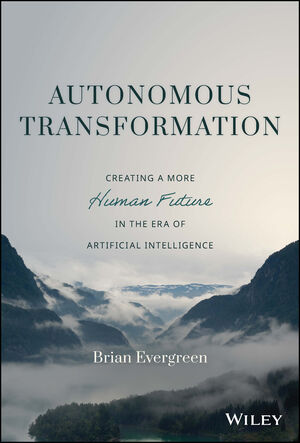Brian Evergreen reviews the principles, frameworks, and methods that have been designed from experience across industries and geographies. He looks at the highest levels of organizations through discussions and stories shared by leaders across the private and public sectors, as means of directing purposeful change in the face of technological upheavals in the context of systems that were built to be maintained—not changed.
Everyone keeps talking about machines taking jobs; is that happening? If so, where and how should we react as leaders and as a society? If not, why is it such a key theme discussed in our culture? Machines are not humans and therefore cannot replace the true definition of a human.
Evergreen confirms that eighty‐seven percent of organizational leaders who have applied the best processes (or approaches to solving problems) to implement machine learning, a subdiscipline of artificial intelligence, have been unsuccessful.
He goes on to share the blueprint to provide leaders with a more human future through the successful implementation of artificial intelligence and other technologies (Internet of Things, digital twins/ simulations, robotics, and mixed reality) that comprise Autonomous Transformation.
What does the process of Autonomous Transformation really mean. Evergreen explains that the transformation of jobs across all verticals and levels, increasing the autonomy of human workers—existing or capable of existing independently.
Transformation presents a time‐sensitive opportunity to capture and extend expertise to empower organizations to create more value with the same number of resources, ensuring business continuity and job stability.
Evergreen then goes on to explain the definition of Digital Transformation. It is the process of transforming an organization’s products, services, processes, and structures through the reimagining and converting of analog processes and assets to digital processes and assets. Now that’s automation all in keeping the human aspect involved.
This means that a sudden reduction of jobs due to automation or machine autonomy is the result of either a failure to plan, a failure to communicate, or an intentional choice to withhold information regarding a coming change.
Evergreen looks through philosophical lens in which the technology‐fueled evolution of work and society examined is the belief that there is little or nothing that can be done to protect jobs or industries in the face of economic changes or competition. This view holds that the forces of globalization, technological advancement, or other factors are so powerful that they will inevitably lead to the loss of certain types of jobs or industries, regardless of any efforts to protect them. Both of these beliefs are short‐sighted and ill‐suited for the era of artificial intelligence.
In the context of the future of the job market, a pragmatic approach would involve balancing the need to support existing jobs with the need to promote innovation, growth, and efficiency in the economy as a whole. It’s not always about replacing or eliminating jobs and/or positions.
This might involve measures such as targeted training and education programs, incentives for businesses to invest in new technologies and processes, and social safety nets to support workers during periods of transition or displacement.
Organizations thrive when they focus on creating customer value and treating employees and customers well. If the leadership of an organization is solely asking the question of how to survive, how to beat the competition, or how to cut costs, it can be easy to lose sight of why the organization got into the business in the first place. Today’s successful organizations take care of their employees and recognize that, without them, they would not be where they are today. It’s not only about the bottom dollar but it’s about the human factor throughout the organization.
In the era of artificial intelligence, if you are a manager or organizational leader and there is a possibility that your team members are experiencing uncertainty about the future of their livelihoods against the backdrop of technological upheaval, there are both economic and moral reasons to create and communicate clarity.
Evergreen reaffirms that leaders who approach each new technological breakthrough with a focus on generating clarity for their stakeholders, organizations, and team members will realize an economic benefit and contribute to a healthy workplace in which team members can focus on doing their best work while continuing to learn and grow.
Machines do not possess the fundamental building blocks of the human psyche. Blockchain, much like the technologies within the scope of Autonomous Transformation, has tremendous capability to advance progress and contribute to the creation of a more human future, but in order to achieve its potential, it will require systemic design, the creation of Profitable Good market dynamics, and surprising and remarkable partnerships.
Do you want to know how the successful organizations are succeeding in this everchanging world and how leaders have succeeded at retaining the human aspect of the organization while growing with the technological changes, read on to Evergreen’s views and stories in this book and be prepared to change and transform!
Monique Vander Eyken, HR Consultant – MVE Consulting









